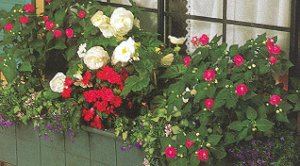
Shady Places Window Box

Blooms for Shady Places Window Box
48 inch window box
Fill window box with potting soil mixed with some slow release fertilizer.
2 " Rose Accent" Impatiens, to be placed on either end of window box. With deep, flossy, green or bronze foliage growing 12 to 15 inches high in shade and a variety of colors to choose from, makes this a perfect plant to
brighten a shady spot.
Will grow in any average soil. In deep shade, bloom will diminish. Heavy watering encourages
vigorous growth; higher light dwarfs them.
Propagate by seed or cuttings. Sow seeds 10-12 weeks before last frost date. Keep
seeds moist, but do not cover, since seeds need light to germinate. Germination time is 10-20 days at 75 degrees F. Use a sterile soil mix because young
Impatiens seedlings are prone to damping off disease. A fungicide is recommended. Cuttings root in 10 - 14 days.
Good for containers, beds, borders and planting strips.
2 Non-stop Tuberous Begonias, planted in back center of box. Tuberous Begonias at their biggest, have salad plate size flowers. Coming in many flower types both upright and pendulous, single or double bloomed with plain or frilled petals in a wide variety of colors. They have large arrow shaped leaves. Both large and small tuberous begonias alternately bear male ( ravishing beautiful) and female ( single, smaller) flowers.
Grow best in mid-day afternoon shade, otherwise foliage will scorch. Need rich, well drained soil high in organic matter. Allow soil to dry between
watering. Some may require stalking.
Propagate by seed or cuttings. When tiny pink growth appears on the upper side ( with depression where last years stem was attached) place the tuber with hollow side up at soil level in a pot filled with packaged soil mix.
Water well once to firm the tuber in the pot and provide a temperature of 68 degrees F. As the top swells and grows, roots will be forming below the surface. DO NOT ALLOW the soil to dry out! But avoid over watering until the leaves expand. Provide high light until time for planting outside when all danger of frost has passed, and the ground is warm. Carefully plant at the same level as the begonia growing in the pot.
1 New Guinea Impatient planted in front of tuberous begonias. This plant was found by a hunting expedition in Southeast Asia and is being developed into
varieties quite different from traditional Impatiens.
This plant is a form of compact, succulent sub-shrubs with branches up to 2 feet tall by the end of summer. Long, narrow, green, bronze or purple leaves with flowers growing up to 2 inches in diameter in a variety of lush colors.
Needs fertile, moist soil high in organic matter and will tolerate more sun than other
Impatiens if roots are kept moist. Use a slow release fertilizer in the soil before planting. Plant only after all danger of frost is pass and ground is warm.
Propagate by seeds or cuttings. Sow seeds 10-12 weeks before plating outdoors. Germinate at 75 to 80 degrees F. DO NOT COVER, seeds need light to germinate. Cuttings root quickly in 2-3 weeks.
Use in planters and hanging baskets as a grouping of 3 or more around garden features and in beds and borders.
2 Lamiiums to be positioned on either side of the New Guinea
Impatiens. Also known as nettles or dead nettles this plant is usually considered a weedy plant called " dead" since these plants can't cause pain like the stinging nettles they resemble.
Sprawling plants with square stems, oval shaped, toothed leaves and 1 inch long flowers that resemble snap dragons. Bloom in May and June in good, well drained garden soil. More robust in partial shade and moist soil, yet are reasonably drought resistant. Propagate by division in spring.
Excellent ground covers and border edgings.
6 Lobelias, planted along front of window box. This intense blue perennial is too tender to
survive winter in most parts of the U.S. so is grown as a annual. Small round leaves and flowers 1/2 inch in diameter has trailers that can reach 12 to 18 inches long by summers end. Cluster lobelias have mounds reaching 6-8 inches high.
Grows best in cool area where night time temperatures are moderate. Will bloom well in partial shade if roots areas are mulched and kept moist.
Propagate by seed which needs light to germinate. Start indoors 10-12 weeks before planting outdoors at 70 degrees F. This takes 20 days. Watch for damping and plant in clumps of several seedlings.
Uses: good for between patio stones, as pockets in rock gardens, edgings and beside paths and walk ways.